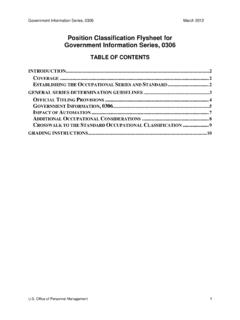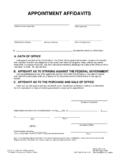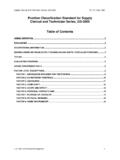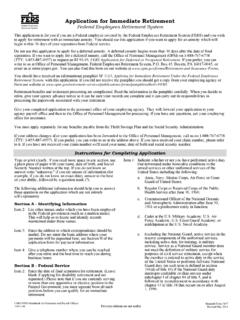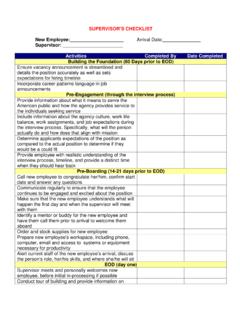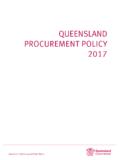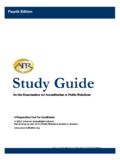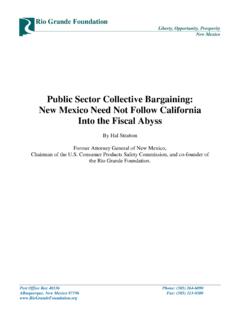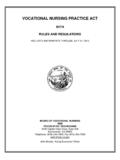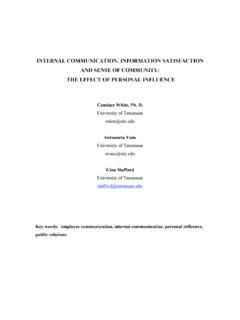Transcription of Labor-Management Relations in the Executive Branch
1 Labor-Management Relations in the Executive Branch October 2014 TABLE OF CONTENTS I. Highlights of the Report .. 1 II. Introduction .. 2 III. Framework for Federal Sector Labor-Management Relations .. 4a. Historical Context .. 4b. Neutrals Involved in Administering the Federal Service Labor-Management Relations Statute 5 i. The Federal Labor Relations Authority (FLRA) .. 51. The Authority .. 52. The Office of the General Counsel of the Authority .. 53. Federal Service Impasses Panel (FSIP).
2 6ii. Federal Mediation and Conciliation Service (FMCS) .. 6iii. 7c. Official Time .. 7i. Official Time Statistics for Fiscal Year 2012 .. 9ii. FY 2012 Official Time Survey Findings .. 9iii. Comparison of Hours Reported to Previous Fiscal Year .. 10iv. Official Time Rates .. 10v.. 10vi. Summary of Official Time Usage .. 11d. Labor Unions and Employee Engagement .. 11IV. Executive Order 13522 .. 12a. Background .. 12i. Establishment of the National Council on Federal Labor-Management Relations .. 12ii. Creation of Labor-Management Forums .. 13iii. Engage in Pre-Decisional Involvement (PDI).
3 13iv. Provide Labor-Management Training .. 14v. Evaluate Progress and Improvements in Organizational Performance .. 14b. Government-wide Training and Guidance .. 15i. National Council on Federal Labor Management Relations .. 15ii. Federal Labor Relations Authority (FLRA) .. 16iii. Federal Mediation and Conciliation Service (FMCS) .. 16c. Perspectives from the Workplace .. 17i. The Climate .. 17ii. Characteristics of Successful Labor-Management Forums .. 18iii. Barriers Encountered by Labor-Management Forums .. 19d. Improvements in Organizational Effectiveness and Employee Engagement Resulting from Labor-Management Forums.
4 20V. Conclusions .. 22 Appendix A Official Time Definitions and Terminology .. 23 Appendix B Comparison of Hours Reported to Previous Fiscal Year .. 24 Appendix C Official Time Rates (Hours Per Employee (HPE) rate) .. 28 Appendix D Official Time Cost .. 32 Appendix E Official Time Summary by Agency FY 2012 .. 35 ii I. Highlights of the Report Federal employees have engaged in collective bargaining through labor organizations for over fifty-two years. The Federal Service Labor-Management Relations Statute (Statute) provides the primary framework for employees to participate in labor organizations and collective bargaining.
5 The Office of Personnel Management (OPM) is publishing this report on Labor-Management Relations in the Executive Branch in order to provide a more comprehensive understanding of federal sector Labor-Management Relations than previously offered through our reports on official time usage in the Federal Government. Highlights of this report include: In enacting the Statute, Congress found that the public interest demands the highest standards of employee performance and the continued development and implementation of modern and progressive work practices to facilitate and improve employee performance and the efficient accomplishment of the operations of the Government.
6 1 With 60% of the non-postal Executive Branch workforce represented by labor unions, the Statute provides both rights and obligations of employees as well as procedures which are designed to meet the special requirements and needs of the Government and are key contributors to aiding in agencies mission performance; The Statute provides both rights to and constraints on collective bargaining. The stated purpose of Chapter 71 of Title 5 of the Code, where the Statute resides, is to prescribe certain rights and obligations of the employees of the Federal Government and to establish procedures which are designed to meet the special requirements and needs of the Government.
7 The provisions of this chapter should be interpreted in a manner consistent with the requirement of an effective and efficient Government. 5 7101(b); Some agencies have already implemented agency Labor-Management forums that are focusing on time and cost-saving initiatives. For example, the Naval Sea Systems Command and Metal Trades Department implemented a program called Hour-a-Day. This program saved workers significant amounts of time on work processes, and these savings translated into significant cost savings to the agency; Examples demonstrate that labor and management can share the goal of cutting costs, enhancing productivity, and improving customer service.
8 For example, labor and management representatives at the Federal Aviation Administration collaborated to implement a new computer system that replaced a 40-year old system used at air route traffic controller centers nationwide; Executive Order ( ) 13522, entitled Creating Labor-Management Forums to Improve Delivery of Government Services, offers an additional labor management forum to 1 5 7101(a)(2). 1 discuss workplace matters and endeavor to develop solutions jointly and collaborate in continuing to deliver the highest quality of goods and services to the American people; In 2013, the National Council on Federal Labor-Management Relations released a Labor-Management Forum Reporting Tool for the purpose of gathering data related to the operations and experiences of Labor-Management forums throughout the Executive Branch .
9 Low-cost and no-cost classroom and web-based training, guidance and tools are available to agencies and unions in meeting their obligations under the and the Statute; and To facilitate working with employee representatives who voluntarily represent the bargaining unit on workplace matters, official time is authorized and permitted under the 5 USC 7131 and collective bargaining agreements. From Fiscal Year (FY) 2011 to FY 2012: o The amount of official time hours used by bargaining unit employees increased slightly by from 3,395, hours to 3,439, hours; and o The total average salary costs for official time hours used by non-postal bargaining unit employees increased slightly by from approximately $ million to approximately $ million.
10 II. Introduction Over the past five decades, the Federal Government s Labor-Management Relations program has evolved from a 1962 Executive Order granting limited collective bargaining rights to a formal collective bargaining program established by statute. A landmark piece of legislation, Title VII of the Civil Service Reform Act (CSRA) of 1978, also known as the Federal Service Labor-Management Relations Statute (Statute), codified in Chapter 71 of Title 5 of the United States Code, has set the tone for Labor-Management Relations in the Federal Government since it became effective.
